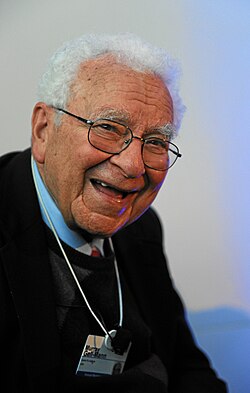Murray Gell-Mann
Murray Gell-Mann (September 15, 1929 – May 24, 2019)[1] was an American physicist who received the 1969 Nobel Prize in Physics for his work on the theory of elementary particles.[3] He was the Robert Andrews Millikan Professor of Theoretical Physics Emeritus at the California Institute of Technology, a Distinguished Fellow and co-founder of the Santa Fe Institute, Professor in the Physics and Astronomy Department of the University of New Mexico, and the Presidential Professor of Physics and Medicine at the University of Southern California.[4]
Murray Gell-Mann | |
|---|---|
 Gell-Mann at the World Economic Forum Annual Meeting, 2012 | |
| Born | September 15, 1929 Manhattan, New York City, U.S. |
| Died | May 24, 2019 (aged 89)[1] Santa Fe, New Mexico, U.S. |
| Nationality | American |
| Citizenship | United States |
| Alma mater |
|
| Known for | |
| Children | Two + 1 stepchild |
| Awards |
|
| Scientific career | |
| Fields | Physics |
| Institutions | |
| Thesis | Coupling strength and nuclear reactions (1951) |
| Website | www |
Gell-Mann has also worked at CERN, as a John Simon Guggenheim Memorial Foundation Fellow in 1972.[5][6]
Works
He was known for his study of particle physics, the smallest parts that make up the universe. These small particles behaved in ways that did not appear to follow the known laws of physics, and Gell-Mann came up with the idea of giving them a strangeness number which could allow them to be compared and put into categories. He also came up with idea that parts of an atom, the proton ad the neutron were made up of even smaller particles. He called the quarks, a nonsense work from James Joyce's book, Finnigan's Wake.[7]
Gell-Mann then developed the idea that quarks were held together inside the nucleus by a force he called "color", and this force could be given a quantum number.[7] With Richard Feynman he discovered a weak interaction between sub-atomic particles. He researched string theory which could explain what makes up the smallest particles and forces.[7]
Personal life
Gell-Mann was an agnostic.[8] Gell-Mann supported Barack Obama for the United States presidency in October 2008.[9]
Gell-Mann died on May 24, 2019 at his home in Santa Fe, New Mexico, aged 89.[10]
Murray Gell-Mann Media
DAVOS/SWITZERLAND, 28JAN12 - Murray Gell-Mann, Distinguished Fellow, Santa Fe Institute, USA, is captured during the session 'The Secrets of the Universe' at the Annual Meeting 2012 of the World Economic Forum at the congress centre in Davos, Switzerland, January 28, 2012..*.*Copyright by World Economic Forum. swiss-image.ch/Photo by Michael Wuertenberg
References
- ↑ 1.0 1.1 Johnson, George (May 24, 2019). "Murray Gell-Mann, Who Peered at Particles and Saw the Universe, Dies at 89". The New York Times. . https://www.nytimes.com/2019/05/24/obituaries/murray-gell-mann-died-.html. Retrieved May 24, 2019.
- ↑ "Professor Murray Gell-Mann ForMemRS". London: Royal Society. Archived from the original on 2015-11-17.
- ↑ "Murray Gell-Mann - Biographical". NobelPrize.org. Nobel Media. Retrieved 17 September 2016.
- ↑ "Nobel Prize Winner Appointed Presidential Professor at USC". Archived from the original on 2010-09-19. Retrieved 2016-09-17.
- ↑ "CERN-affiliated article by Gell-Mann". Springer. doi:10.1007/978-3-7091-4034-5_20. Retrieved 11 June 2015.
{{cite journal}}: Cite journal requires|journal=(help) - ↑ Scientific publications of M. Gell-Mann on INSPIRE-HEP
- ↑ 7.0 7.1 7.2 Murray Gell-Mann Biography -- Academy of Achievement: Murray Gell-Mann Biography -- Academy of Achievement Archived 2016-11-11 at the Wayback Machine, accessdate: September 17, 2016
- ↑ The International Academy of Humanism Archived 2008-04-24 at the Wayback Machine at the website of the Council for Secular Humanism. Retrieved 18 October 2007. Some of this information is also at the International Humanist and Ethical Union Archived 2012-04-18 at the Wayback Machine website
- ↑ Nobel Laureate Murray Gell-Mann endorses Obama, at youtube.com Retrieved 15 February 2017
- ↑ "Murray Gell-Mann passes away at 89". Press release. May 24, 2019. https://santafe.edu/news-center/news/murray-gell-mann-passes-away-89. Retrieved May 24, 2019.
Other websites
![]() Media related to Murray Gell-Mann at Wikimedia Commons
Media related to Murray Gell-Mann at Wikimedia Commons
![]() Quotations related to Murray Gell-Mann at Wikiquote
Quotations related to Murray Gell-Mann at Wikiquote

